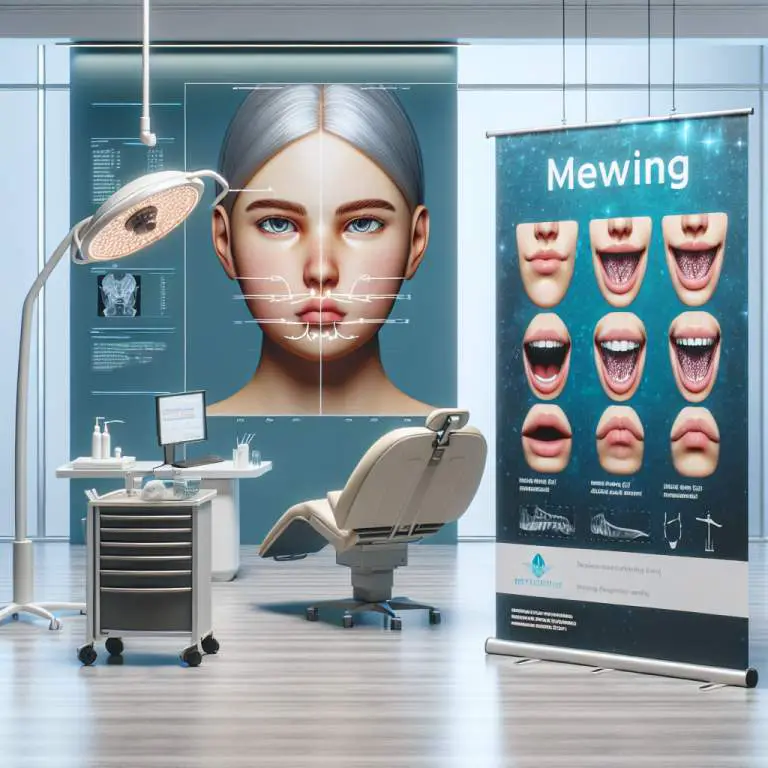How to start mewing for jawline enhancement?
To start mewing for jawline enhancement, first, ensure your tongue rests completely against the roof of your mouth. Next, keep your lips together and teeth lightly touching or slightly apart. Practice this posture consistently throughout the day to train your muscles. This technique can gradually shape your jawline by improving your tongue’s posture.

How does mewing work to enhance the jawline?
Mewing is a technique that involves positioning your tongue against the roof of your mouth. This action is supposed to help shape and define your jawline over time. The idea is that by doing this, you’re exercising the muscles around your jaw and neck.
When you practice mewing correctly, it’s believed that you can actually change how your face looks. This doesn’t happen overnight, but many people say that after doing it for a while, they notice their jawline looks stronger and more defined.
What are the correct techniques for starting mewing?
To start mewing properly, you first need to make sure your tongue is in the right position. The whole flat part of your tongue should be pressed against the roof of your mouth. Your lips should be closed, but your teeth should have a slight gap between them.
It’s important to breathe through your nose while doing this. Keeping this position as often as you can throughout the day is key. It might feel weird or hard at first, but with practice, it becomes easier.
Can anyone do mewing, or are there limitations?
Pretty much anyone can try mewing. However, it might be easier for some people than others. For example, if someone has been breathing through their mouth for most of their life, switching to breathing through their nose (which is necessary for mewing) can take some getting used to.
Also, while there’s no age limit to start mewing, younger individuals might see results faster because their bones are still growing and shaping. But even if you’re older, you can still give it a try and see improvements over time.
What are the common mistakes beginners make while mewing?
A common mistake many beginners make is not placing their entire tongue on the roof of their mouth. Some just use the tip of their tongue which doesn’t provide the full benefits of mewing. It’s crucial to ensure that as much of your tongue as possible is pressed up against the roof of your mouth.
Another mistake is forgetting to keep up with it throughout the day. Mewing isn’t something that works if you only do it once in a while; consistency is key. Also, remember not to clench your teeth too hard or strain yourself too much when trying to keep your tongue in place.
| Step | Description | Tips |
|---|---|---|
| 1. Correct Tongue Posture | Place the entire tongue on the roof of your mouth, including the back of the tongue. | Ensure your mouth is closed but not clenched. Breathe through your nose. |
| 2. Chin Tuck Exercise | Push your head backwards while keeping your gaze forward to create a double chin effect. | Hold for 5 seconds, repeat 10 times daily. |
| 3. Swallowing Technique | Practice proper swallowing by engaging the muscles in your throat and mid-face, not just moving the jaw. | Avoid using cheeks to swallow; it should feel like a smooth motion. |
| 4. Consistency is Key | Maintain correct tongue posture as much as possible throughout the day. | Incorporate reminders or alarms to check on your posture regularly. |
| Note: Mewing is a slow process and results vary among individuals. Consultation with an orthodontist or facial growth specialist is recommended for personalized advice. | ||
How long does it take to see results from mewing for jawline enhancement?
Seeing results from mewing can vary greatly among individuals. Some people may notice changes in a few months, while others might need to practice consistently for over a year. The process is gradual and requires patience.
The time it takes to see noticeable improvements depends on several factors, including the person’s age, the consistency of their practice, and their natural bone structure. Younger individuals tend to see results faster due to the natural flexibility of their bones.
Are there any exercises that complement mewing for better results?
Yes, there are exercises that can complement mewing and potentially enhance its effects on the jawline. Chin tucks and neck curls are popular options that target the muscles around the neck and under the jaw. These exercises can help in achieving a more defined jawline when combined with mewing.
Additionally, maintaining overall physical fitness and a healthy diet can support changes in facial structure. Staying hydrated and reducing sodium intake can also reduce puffiness around the face, making the jawline appear more prominent.
What evidence supports the effectiveness of mewing for jawline shaping?
The evidence supporting mewing is mostly anecdotal, with many individuals sharing their personal success stories online. However, there is a growing interest in scientific research exploring how orthotropic practices like mewing influence facial structure.
Some studies suggest that proper tongue posture can have an impact on facial development, especially in younger individuals. Yet, definitive scientific consensus on mewing’s effectiveness for adults remains limited. It’s important to approach mewing with realistic expectations and understand that results may vary.
Final Thoughts
Mewing has gained popularity as a technique for enhancing the jawline through improved tongue posture. While some people report positive changes, it’s crucial to remember that results can take time and may not be dramatic for everyone.
If you’re considering starting mewing or incorporating complementary exercises into your routine, it’s wise to do so with patience and consistency. Remembering that individual experiences differ greatly will help set realistic expectations for what you hope to achieve with your jawline enhancement efforts.






